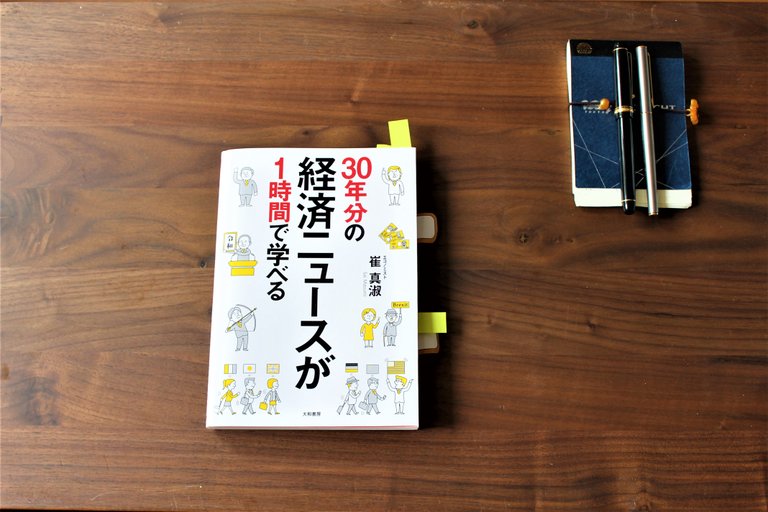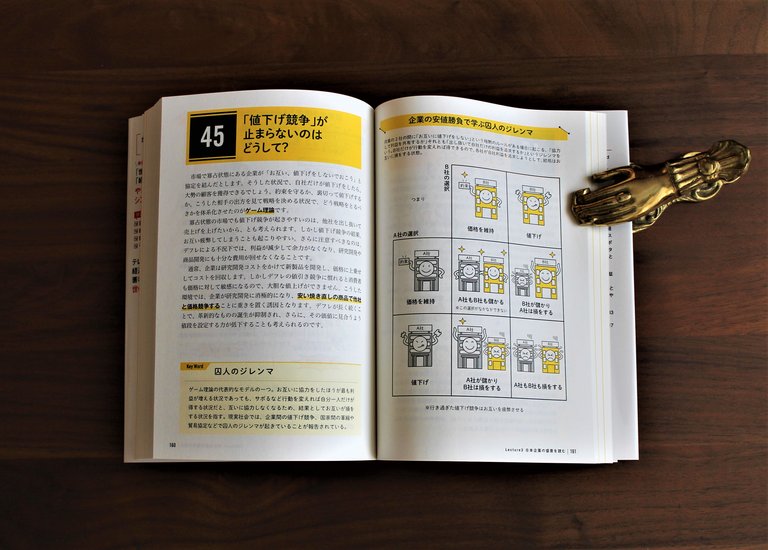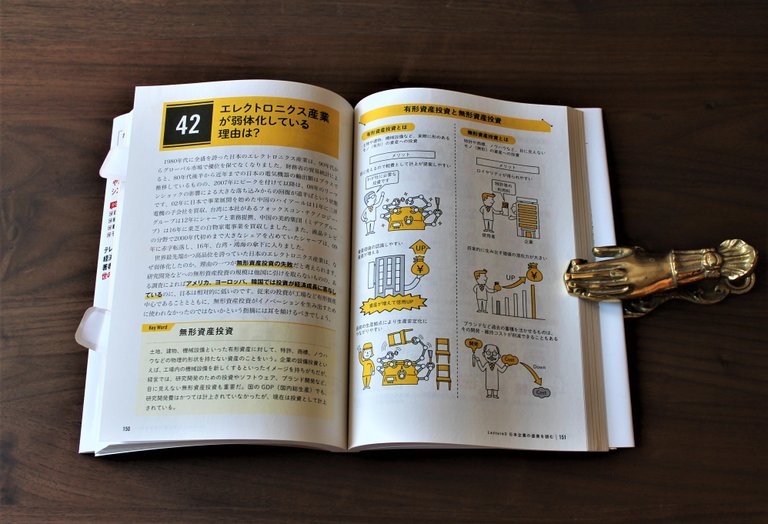今日も引き続き、30年分のニュースを経済学の視点から振り返ってみたい。
Continuing, I would like to look back on 30 years of news from an economics point of view, with 『30年分の経済ニュースが1時間で学べる』(30 years worth of economic news can be learned in 1 hour: Masumi Sai).
『30年分の経済ニュースが1時間で学べる』
崔 真淑 (著) 大和書房
■バブルからデフレへ=イノベーションのジレンマ+囚人のジレンマ
From bubble economy to deflation= Prisoners' Dilemma + The Innovator's Dilemma
1989年12月29日、日経平均株価は史上最高値の3万8915円を付けた。1989年の世界時価総額ランキングの1位はNTT、2位は日本興業銀行、3位は住友銀行だ。1989年、1992年、1994年の世界の億万長者ランキングの1位は日本人だ。
On December 29, 1989, the Nikkei Stock Average hit a record high of 38,915.87 yen.
In 1989, NTT ranked first in the world market capitalization rankings, second ranked Japan Industrial Bank, and third ranked Sumitomo Bank.
The first in the world millionaire rankings of the world in 1989, 1992 and 1994 is Japanese.
その後のバブル経済の崩壊を経て、日本は失われた30年に入る。失われた~の後にいろいろな年数が入って呼ばれるが、本書は30年が失われたとする。
After the collapse of the bubble economy, Japan enters the "lost 30 years".
平成という30年を振り返ると、経済で敗北した時代とよく言われる。あるいは、戦わずして負けたと言われる。
Looking back on the 30 years of Heisei, it is often said that the economy was defeated. Or, it is said that he lost without fighting.
バブル崩壊からの歴史の流れを我々は忘れがちだ。
本書はバブル崩壊からの歴史の流れも思い出させてくれる。1997年から1978年にかけて、数多くの大手金融機関が破綻した。
We tend to forget the flow of history since the collapse of the bubble economy. This book looks back on the history from that time. Many major financial institutions went bankrupt from 1997 to 1978.
日本の金融機関は長年の間、厳しい規制に守られていた。1996年末に、バブル経済崩壊をきっかけに規制緩和を行う日本版「金融ビッグバン」と呼ばれる規制緩和が行われた。
Japan's financial institutions have been bound and protected by strict rules for a long time.
At the end of 1996, a deregulation called the "Financial Big Bang" in Japan was conducted in which deregulation was triggered by the collapse of the bubble economy.
金融機関の破綻の背景には、金融機関に対してフェアであることを求めた、この改革がある。
Behind the bankruptcy of financial institutions is this reform, which called for financial institutions to be fair.
いずれにしても、バブル経済が崩壊した後でも、金融機関が破綻することは、当時の日本では全く考えられないことだった。
Even after the bubble economy collapsed, the failure of financial institutions was totally unthinkable in Japan at that time. That was a huge shock to people.
■
■■
こうした中で何が起きたか? デフレーションが到来した。安くしないとものが売れなくなり、1998年にマクドナルドは、実験的にハンバーガーを65円で販売した。ちなみに現在のドル円相場で、1ドルは約112円くらいだ。
What happened under these circumstances? The deflation has arrived.
Things would have to sell if it wasn't cheap, and in 1998 McDonald's sold hamburgers for 65 yen experimentally. By the way, one dollar is about 112 yen at current dollar yen market price.
値下げ競争に火が付き、日本はものやサービスの値段が下がり続け、経済が縮小していくデフレーションから抜け出せなくなっていく。これが「失われた30年」の間、日本がかかっていた病だといえる。
In Japan, prices of goods and services continued to fall, and the economy could not escape from deflation.
It can be said that this is a disease which Japan was suffering during the "lost 30 years".
値下げ競争がなぜ止まらないのか? 著者は「ゲーム理論」を用いて解説する。
Why does price cut competition stop? The author explains using "Game Theory".
たとえ寡占市場であっても、値下げ合戦が起きやすいのは、他社を出し抜いて売上を上げたいからといえる。有名な「囚人のジレンマ」を用いれば、各社が自社利益を追求しようとして合理的に値下げという戦略を取ると、結局、各社とも疲弊してしまう。
The price cut battle is more likely to occur because companies want to outperform other companies and increase sales.
If you use the famous "Prisoner's Dilemma", companies will eventually get tired if they take a strategy of price reduction in pursuit of profits.
著者が語るポイントは、ここからだ。デフレによる不況の下では、企業の収益は下がり、研究開発や商品開発に十分な費用が回せなくなる。
The point the author talks about is from here.
Under deflationary recession, corporate profits decline. Because of this, companies can not afford sufficient funds for research and development and product development.
企業は研究開発に消極的になり、安価な、今までの商品の焼き直しのような新製品で他社と価格競争をすることになる。
Then, companies improve their existing products and compete with other companies for price.
著者は、デフレが長く続くことで、革新的な新製品の誕生が抑制され、さらに、その価値に見合うような値段を設定する力が低下することが考えられる、と指摘する。
The author points out that prolonged deflation will lose the opportunity to create innovative new products. She also pointed out that the ability to set prices commensurate with the original value of the product may be reduced.
■
■■
この指摘は、本書の別の項目で登場する「イノベーションのジレンマ」が引き起こす結果とも関係するように感じた。
I felt that this point of the author was also related to the consequences of the "The Innovator's Dilemma" that appears in other part of this book.
成功した企業は過去の成功体験から、自社が強い技術への投資を続け、企業価値を高めようとする。その結果、リスクのある新しい分野の開発には目を向けにくい。
Successful companies try to continue investing in strong technology from their past successful experiences to increase corporate value. As a result, it is difficult to look at the development of new areas at risk.
このような持続的イノベーションは、ある時期までは十分な利益をもたらすが、破壊的イノベーションを持った新興企業が現れると、状況が変わる。
Such sustainable innovation will provide sufficient benefits until some time, but the situation changes when emerging companies with disruptive innovation appear.
破壊的技術への投資に出遅れたリーダー企業は変化に対応できず、顧客に受け入れられなくなり、リーダーの地位を失う。
Leaders who are late to invest in disruptive technology can not respond to change. Over time they will not be accepted by customers and lose their leadership position.
著者はこう解説する。「イノベーションのジレンマとは、このように、長く成功してきた企業ほど、自ら業務プロセスや価格基準、そして組織文化によって、破壊的イノベーションへの組織的対応を拒んでしまうことをいう」。
The author explains as follows. "The innovation dilemma means that the longer companies succeed, they tend to refuse to respond systematically to disruptive innovation, depending on their business processes, price standards, and organizational culture."
著者はまた、日本のエレクトロニクス産業が弱体化している理由の一つとして、「有形固定資産中心に投資が行われ、無形資産投資は行われたものの、それがイノベーションを生み出す目的に使われなかった」という指摘があることを述べている。
この点を付け加えておきたい。
The author also notes that experts point out the following as one of the reasons why Japan's electronics industry is weakening. "Even though tangible fixed assets were invested and intangible assets were invested, it may not have been used for innovation."
I would like to add this point.
一方でデフレを背景にした「囚人のジレンマ」による価格競争があり、他方で高度経済成長からバブルに至る好景気を成功体験とした「イノベーションのジレンマ」があった。「失われた30年」を因数分解していくと、その2つのジレンマが現れるのだろうか?
On the other hand, there was a price competition due to the “Prisoners' Dilemma” against the backdrop of deflation, and on the other hand, there was a “The Innovator's Dilemma” in which the favorable economy from high economic growth to bubbles was a successful experience.
If We analyze "the lost 30 years", will the two Dilemmas appear?
■
■■
しかし、この30年はそれほど酷い時代だっただろうか? 個人的には、そこそこ良い時代だった。正直に言うと、非常にハッピーに過ごすことができた。
But, has it not been such a bad time for the past 30 years? To be honest, I was able to spend very happy.
今のところ世界のGDPの約6%を占め、国内で経済を回していかれる余裕があるせいか、あるいは過去の成功体験から抜け出していないのか、政府が経済政策「アベノミクス」の成功を強調するからか、「まだ大丈夫」「これからも大丈夫」という楽観論があるように思える。
Now that it accounts for about 6% of the world's GDP, the economy can afford to circulate in the country, or is it not coming out of past successful experiences, is it because the government emphasizes the success of economic policy "Abenomics"? It seems that there is optimism that "it's still okay" and "it's okay from now on".
これも正直に言うと、自分の中からも「まだ大丈夫」「これからも大丈夫」という言葉が聞こえてきたりもする。
To be honest, I can hear the words "it's still okay" and "it's okay from now on".
■
■■
「平成」を振り返り、歴史として収める作業をしながらも、警句は頭のどこかに残しておかなければ。
Looking back on the 30 years of "Heisei", while working to put it in history, I have to leave "Warning from History" in my head.


